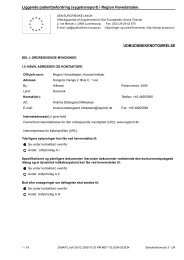Territorial Review Copenhagen - Region Hovedstaden
Territorial Review Copenhagen - Region Hovedstaden
Territorial Review Copenhagen - Region Hovedstaden
Create successful ePaper yourself
Turn your PDF publications into a flip-book with our unique Google optimized e-Paper software.
185<br />
square is nearly void of green landscaping. In terms of temporary use, the<br />
square has accommodated parades and football-watching for national<br />
Danish teams. Few temporary exhibits, however, have used this space to<br />
educate the public on environmental issues. Paris‘ use of temporary<br />
landscaping may provide a useful model for <strong>Copenhagen</strong>. For one month in<br />
2008, Paris‘ ―Jardin éphémère‖ or temporary garden comprised nearly 6 000<br />
plants of 52 different species around a 330 m² pond directly in front of City<br />
Hall. 45 This could especially be used to showcase the ecology of Denmark<br />
during the COP15 Conference. In the future, urban landscaping could be<br />
better integrated into such initiatives as the <strong>Copenhagen</strong> Urban Space Action<br />
Plan (CUSAP).<br />
Reducing energy consumption and waste<br />
Improved energy conservation techniques would be useful to reduce<br />
<strong>Copenhagen</strong>‘s ecological footprint. ―Smart meters‖ are being rolled out in<br />
Denmark that would give customers the chance to monitor their energy<br />
consumption in real time. These should be coupled with rates that vary by<br />
season and time of the day, rewarding customers who shift energy use to<br />
off-peak periods. Consumers might also be given greater choice in how their<br />
energy is produced. For example, the Blue Sky program, a partnership<br />
between the United States‘ state of Utah and its consumers, gives residents<br />
an opportunity to help increase the demand for renewable energy by paying<br />
for the incremental difference between power from market cost energy and<br />
wind power and other renewable sources. Through this program, Utah<br />
Power purchases 452 megawatts per month of renewable energy, which<br />
offsets approximately 3 800 tonnes of greenhouse gas per year (Envision<br />
Utah, 2006). Additional programs could be designed in <strong>Copenhagen</strong> where<br />
energy conservation is integrated into urban design, infrastructure planning,<br />
and urban regeneration/brownfields redevelopment. London is saving large<br />
amounts of energy from construction by mandating that the development of<br />
the Olympics site reuse many of the materials from the industrial zone.<br />
Private developers have a key role to play in constructing more energyefficient<br />
buildings. Already the City of <strong>Copenhagen</strong> through its<br />
―Sustainability in Construction and Civil Works‖ guidebook, has given<br />
developers suggestions for environmentally friendly building materials and<br />
designs. This is complemented by the Building Labelling Scheme, which is<br />
implemented by the Danish Energy Authority. During the design phase, the<br />
ecological footprint of new real estate projects could be better minimised<br />
through utilising software tools that suggest environmentally-friendly<br />
design. For instance, the Danish Building Research Institute‘s software<br />
tools, which integrate sustainable concepts into the design phases. BSim, for<br />
example, allows developers to analyze the thermal indoor climate, daylight

















